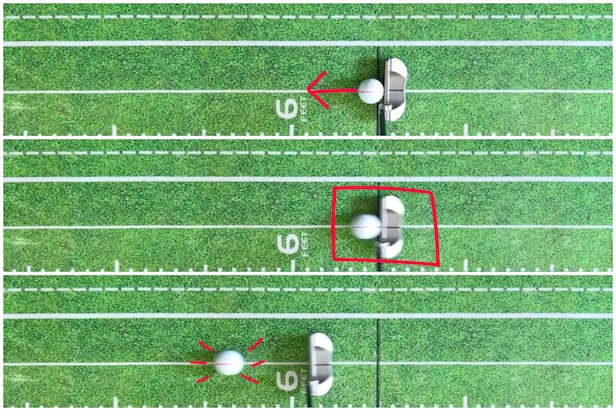Are you overlooking the most obvious reason you’re missing putts? – Australian Golf Digest

- by Admin
- November 27, 2024

Most golfers are willing to try just about anything to get more out of their games, and Alex Myers is no different. In Focus Group of One, he gives a wide-range of golf-related stuff a go, and offers his unscientific—and unpaid—take.
For the first installment of this column, I took my first-ever standalone putting lesson—and took a leap by ditching my longtime putting form at the suggestion of my new coach, Bill Smittle. I then shot my lowest score in 15 years in my next round. How ‘bout that?! But while Bill was happy to hear that result, he still wanted to see me again to discuss something else. And it had nothing to do with my stroke.
Bill wanted to go over green reading and how I line up putts. This led to a discussion about AimPoint, the popular, but controversial green-reading method used by a lot of tour pros (even if most pros today adopt a hybrid approach). It may work for them, but I was apprehensive, and even feared the reaction I’d get using it around my buddies. I may as well wear a scarlet “A” on my shirt.
I was relieved when Bill only gave me a quick crash course on how AimPoint works. He knew that it wasn’t for everyone and that even the genial Jim Nantz had recently said he “can’t stand looking at it.” But as Bill explained, feeling the slope with your feet is extremely useful because how a putt breaks is all based on “time and tilt.” The longer a ball is traveling on that tilt, the more it’s going to break. So identifying that slope has become key, which is why you see more and more tour pros straddling their putting line from different distances instead of only bending down behind their ball to read the green.
FOCUS GROUP OF ONE: Is it time for a putting lesson?
Anyway, to get proficient at AimPoint would take hours of practice stomping around on the putting green so we moved onto lining up putts. I enjoyed Bill, formerly the head pro at Scarsdale Golf Club for more than 30 years, referring to himself as the “Start-Line King” and I was all ears. But isn’t it easy to line up your putts? Turns out, not so much!
After a few minutes of going through my normal pre-putt routine, we discovered that I was almost always aiming to the right of my intended target. Even on short putts when you can keep the hole in your peripheral vision. It was pretty stunning, not to mention, alarming. All year, I had been worried about my putting form, but perhaps it was what I was doing before making a stroke that was holding me back even more. It also made sense that my old method of putting involved me keeping the putter head slightly closed on the way back and through. That was counteracting with being aimed right, meaning that two wrongs were making a right when I made a putt.
So what was Bill’s suggestion for aiming better? For one, he advised me to use a line on my golf ball, which is something I’ve heard and even tried in the past. But he also said something I had never considered: Use your putter shaft. To do this, you first crouch behind the ball and get the line pointed in the direction you want. Then, using your dominant eye, hold your putter up in front of you to confirm that the line on the ball lines up with the shaft all the way to where you’re aiming by the hole.
RELATED: Yes, this is a legal way to aim your putter
When should you go through this process? Bill gave 30 feet as an approximate cutoff point, but it’s really for putts you think you have a realistic chance of holing. One additional thing: Depending on which way you see the putt breaking, use that side of the putter shaft as your guide. So if it’s a right-to-left break, you line it up using the left side of the shaft and if it’s a left-to-right break, you use the right side of the shaft.
As I did after changing my putting stroke, I spent a ton of time over the next couple weeks practicing this. I didn’t find it particularly easy to do as it would often take me multiple efforts to get the line lined up where I wanted. And the last thing I want to do is hold up my group. So I’ll continue to practice in order to speed up the process.
If you don’t feel comfortable doing this, there are other ways to line up putts. In fact, our Luke Kerr-Dineen recently offered some suggestions in his Golf IQ newsletter. The bottom line is that you could have the best putting stroke in the world, but it’s not going to help much if you’re not aiming correctly so you should double check what you’re doing is working.
After my two sessions with Bill, I’m feeling more confident about my new putting stroke and my new way of lining up putts. When I miss a putt now, I can usually chalk it up to a bad read. So once I feel more comfortable with both, maybe I’ll experiment more with identifying the slope with my feet. Bill says you don’t have to go full AimPoint, but straddling your line can be an extra tool when assessing your putt.
Bill also suggested picking out a spot on the green about a foot in front that you try to get your putt to roll over once you have it lined up. But I found that by properly being lined up, I didn’t need to add that. Well, for now. Besides, he’s given me enough already to work on this offseason. Hopefully, by spring I’ll be at least on track to earn the title of “Start-Line Prince.”
RELATED: This training aid is all over Instagram. Can it actually help your golf game?
This article was originally published on golfdigest.com
The Latest News
-
November 28, 2024Smith and Herbert make bright starts as young Japanese player lights up Kingston Heath
-
November 28, 2024In-form Webster surging into Test contention after Australia’s big loss to India
-
November 28, 2024Maxwell’s huge ‘all-time’ call on unplayable Bumrah
-
November 28, 2024Top young talent on show
-
November 27, 2024Fox Footy icon opens up on ‘incredible’ media shift — and ‘golden ticket’ to find next star





